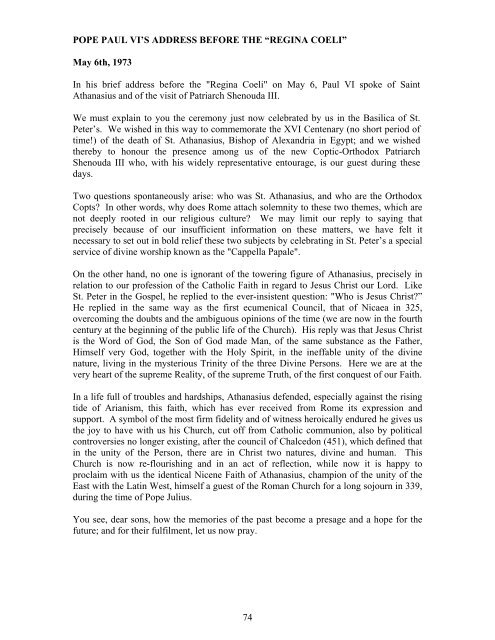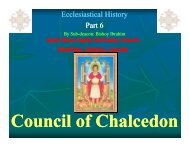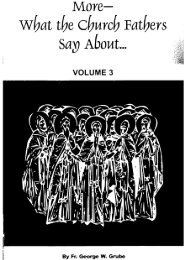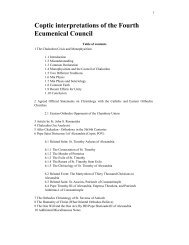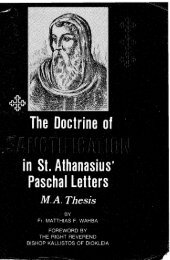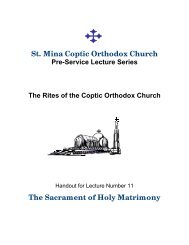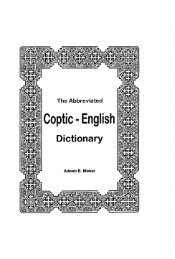Coptic Church & Ecumenical Movement - Saint Mina Coptic ...
Coptic Church & Ecumenical Movement - Saint Mina Coptic ...
Coptic Church & Ecumenical Movement - Saint Mina Coptic ...
Create successful ePaper yourself
Turn your PDF publications into a flip-book with our unique Google optimized e-Paper software.
POPE PAUL VI’S ADDRESS BEFORE THE “REGINA COELI”<br />
May 6th, 1973<br />
In his brief address before the "Regina Coeli" on May 6, Paul VI spoke of <strong>Saint</strong><br />
Athanasius and of the visit of Patriarch Shenouda III.<br />
We must explain to you the ceremony just now celebrated by us in the Basilica of St.<br />
Peter’s. We wished in this way to commemorate the XVI Centenary (no short period of<br />
time!) of the death of St. Athanasius, Bishop of Alexandria in Egypt; and we wished<br />
thereby to honour the presence among us of the new <strong>Coptic</strong>-Orthodox Patriarch<br />
Shenouda III who, with his widely representative entourage, is our guest during these<br />
days.<br />
Two questions spontaneously arise: who was St. Athanasius, and who are the Orthodox<br />
Copts? In other words, why does Rome attach solemnity to these two themes, which are<br />
not deeply rooted in our religious culture? We may limit our reply to saying that<br />
precisely because of our insufficient information on these matters, we have felt it<br />
necessary to set out in bold relief these two subjects by celebrating in St. Peter’s a special<br />
service of divine worship known as the "Cappella Papale".<br />
On the other hand, no one is ignorant of the towering figure of Athanasius, precisely in<br />
relation to our profession of the Catholic Faith in regard to Jesus Christ our Lord. Like<br />
St. Peter in the Gospel, he replied to the ever-insistent question: "Who is Jesus Christ?”<br />
He replied in the same way as the first ecumenical Council, that of Nicaea in 325,<br />
overcoming the doubts and the ambiguous opinions of the time (we are now in the fourth<br />
century at the beginning of the public life of the <strong>Church</strong>). His reply was that Jesus Christ<br />
is the Word of God, the Son of God made Man, of the same substance as the Father,<br />
Himself very God, together with the Holy Spirit, in the ineffable unity of the divine<br />
nature, living in the mysterious Trinity of the three Divine Persons. Here we are at the<br />
very heart of the supreme Reality, of the supreme Truth, of the first conquest of our Faith.<br />
In a life full of troubles and hardships, Athanasius defended, especially against the rising<br />
tide of Arianism, this faith, which has ever received from Rome its expression and<br />
support. A symbol of the most firm fidelity and of witness heroically endured he gives us<br />
the joy to have with us his <strong>Church</strong>, cut off from Catholic communion, also by political<br />
controversies no longer existing, after the council of Chalcedon (451), which defined that<br />
in the unity of the Person, there are in Christ two natures, divine and human. This<br />
<strong>Church</strong> is now re-flourishing and in an act of reflection, while now it is happy to<br />
proclaim with us the identical Nicene Faith of Athanasius, champion of the unity of the<br />
East with the Latin West, himself a guest of the Roman <strong>Church</strong> for a long sojourn in 339,<br />
during the time of Pope Julius.<br />
You see, dear sons, how the memories of the past become a presage and a hope for the<br />
future; and for their fulfilment, let us now pray.<br />
74


